This CE Center article is no longer eligible for receiving credits.
Accurate Documentation Made Easy
Historically, the construction documentation phase is where architects spend the majority of their time. Automating the completion and management of the incredible amount of documentation necessary in the building industry is one of the benefits of BIM that is most widely touted. BIM applies a revolutionary approach to documentation in that the model and the documentation are connected to each other. A change to the documentation results in an instant change in the model. A change in the model creates an immediate update to all documentation. Now documentation is a product of the design process and not a separate phase.
As previously described, the BIM process relies upon a single data model that contains layers and layers of metadata that is constantly updated so that all of the details are always current, which is an impressive task considering the iterative nature of the design and construction process. If an architect interacts with the 3-D visualization, pulling or pushing structural elements or redefining materials, the changes ripple down into all of the 2-D documents that pull information from the data model. If an architect makes changes to a 2-D floorplan or detailed section or elevation, the changes are reflected in the 3-D representation and, again, in all documentation.
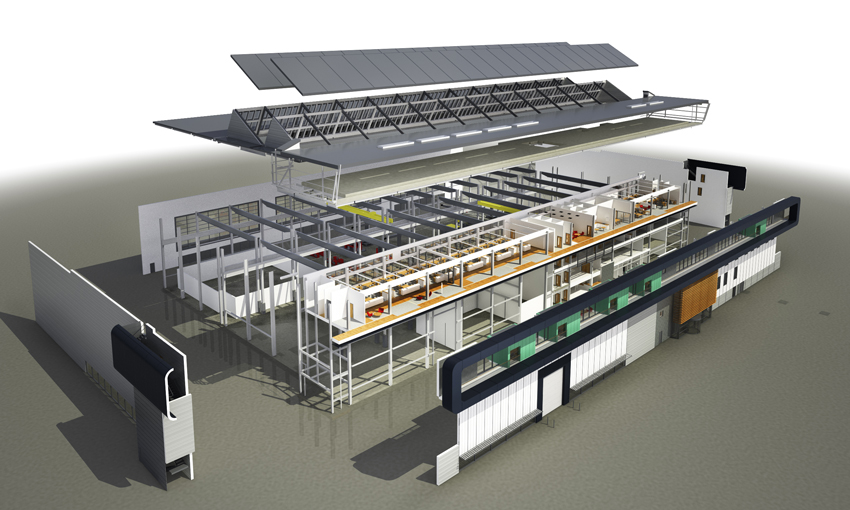
© Bond Bryan Architects, www.bondbryan.com
Project: Nuclear Advanced Manufacturing Research Centre
Location: Sheffield, United Kingdom
With BIM, any design change is immediately reflected across the complete drawing set. For example, if a designer makes changes to the position or height of a door or window, every elevation and piece of documentation updates with this new information immediately, without requiring the designer to update every associated drawing, schedule, or element description by hand.
This automatic process ensures that architects can clearly and accurately communicate design intent with the model, and it eliminates potential errors that result from project members having the wrong information when iterations or changes are not effectively captured in the documentation. BIM software constantly regenerates the most current version of all documentation so team members are never looking at old or outdated details. This minimizes the opportunities for mistakes to occur from miscommunications that could bust project budgets and timelines.
Improved Collaboration
Before BIM, architects passed base sheets and .dwg files back and forth between the engineers and consultants on their team and had to manually input every iteration. Since then, BIM has revolutionized project collaboration, improving the way that a multidisciplinary team communicates, increasing the level of detail that can be shared visually to improve the clarity of the comments and accommodating the many different ways that team members may prefer to work.
Using BIM, architects can easily exchange IFC files between their consulting engineers and use hotlinking solutions to capture and compare the latest iterations of a system or space quickly and efficiently. Objects that have been changed are color coded depending upon the type of change that occurred. One color represents that an entirely new element has been added. Another color represents that something has been moved or modified. A third highlights items that have been removed.
BIM software also allows designers to customize communications to provide greater levels of detail and clarity to the rest of the team. “With BIM software, I can create a vignette, which allows me to pull a piece of the model out, note it up, and include it alongside the orthographic representations of the drawing. It’s a clearer way for me to communicate design intent to the engineer. I can say ‘I want to bury this beam, and I want that to pull out,’ but being able to show them a shot of the model and provide a couple of notes and put that in next to the more traditional drawing is huge,” Hampden explains.
Beyond offering tools to help architects communicate more clearly with the team at large, BIM software offers greater flexibility to support the ways in which consulting engineers prefer to work with the architect. The system can still accommodate .dwg files for design consultants who prefer to complete documentation in 2-D.
The system also enables the team to collaborate in real time on the building models. Architects and structural engineers can work in the same drawing at the same time, see each other’s work, and join the real-time work session from inside the office or a remote location. This gives the design team the ability to be more flexible with each other.
Another BIM feature that makes collaboration easier today is platform neutrality. In the past, platform mattered because it was a challenge to work on projects across iOS and Android devices. The programs were not capable of jumping across platforms in a way that protected the integrity of the original files and was easy to use. Now programs offer seamless design and review capabilities across iOS and Android platforms, making it much easier to collaborate among all project stakeholders regardless of their device preferences.
The Mobile BIM Model
BIM is built upon a database that contains an enormous amount of information about a project. The value of BIM, however, is not that the database exists but that the data can be easily and readily accessed by all of the members of the AEC team. Ensuring the members of the multidisciplinary AEC team, which is often comprised of an MEP engineer, environmental engineer, civil engineer, architect, structural engineer, interior architect, landscape architect, surveyor, general contractor, and subcontractors, is especially challenging because many of the stakeholders are not proficient in BIM or do not have a computer, relying instead upon a mobile device.
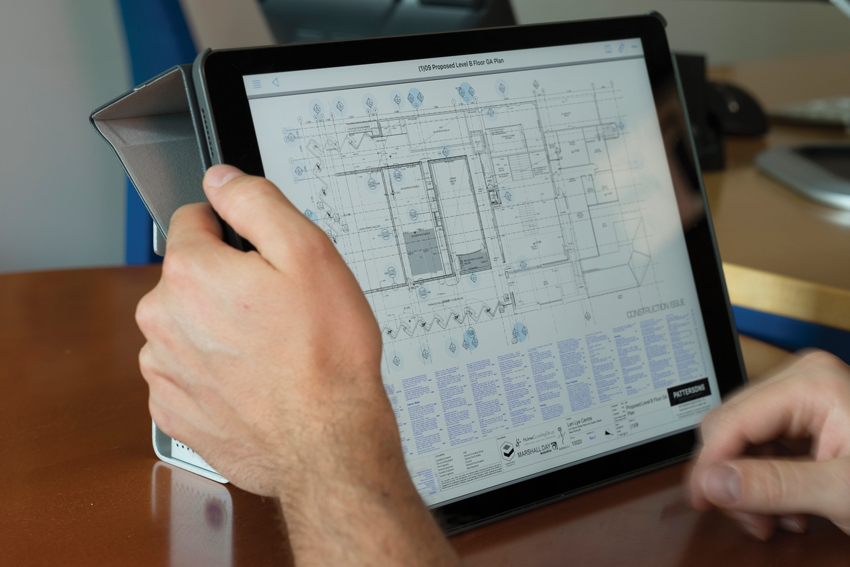
Photo courtesy of GRAPHISOFT
With BIM, accurate project data can be easily and readily accessed by all members of the AEC team from a preferred mobile device.
It is now possible to load the hyper-model of a BIM project and the associated documentation onto a mobile device and take it to the job site, to the client meeting, or anywhere. Now, if an architect is at a construction site discussing an issue with the construction manager, the architect can access the model on his or her mobile phone and even send it directly to the construction manager’s tablet. With BIM being mobile, architects and the rest of the team can share and collaborate on projects using the full range of hardware, tablets, and smartphones they possess.
“The mobile BIM solution has enabled our designs to break free of the confines of the desktop and the studio itself. Now we are able to have the entire rich 3-D model in our pockets. We can put it on the iPad Pro and take it to a construction site. We can upload it to the cloud. With this level of access, structural engineers, general contractors, and real-estate sales people can engage with the design in a much more visually rich way,” says Anthony Laney, Laney LA.
More Beautiful Renderings
BIM can also produce strikingly beautiful images in a still format, animation, or interactive hyper-model, offering the photo-realistic solution for any type of presentation need.
“I was resistant to change everything I do [and make the switch to BIM], but I did see the beauty of what it offered. My first great experience with the BIM software, where the product really upped my game, was the time I presented renderings to the developer of a huge apartment complex. There is nothing I could have drawn that would have elicited that response. They were gorgeous renderings, and the client said, ‘We want to live in that rendering,’” shares Olvia Demetriou, HapstakDemetriou.
Some BIM software now features an integrated rendering engine that offers designers an everyday 3-D window that quickly generates high-quality renderings and project images. This built-in sketch rendering capability makes good presentations filled with project renderings possible on the fly. This is a dramatic departure from past technologies that required architects to dedicate significant time just to developing the images that would be used during a presentation. The software can also produce marquees that carve up the model and provide unique views for clients or members of the consulting engineer or construction team. Animations can also be created by connecting the rendered images with a camera path.
Nudging the quality higher, the sophisticated rendering engine is equipped with light mapping and global illumination (GI) capabilities that adds more realistic lighting to 3-D images. The images now consider light produced by a light source as well as the reflections, refractions, and shadows that occur as a result of the light’s path through a space. These improved renderings create brighter interiors and a better representation of the depth of a room.
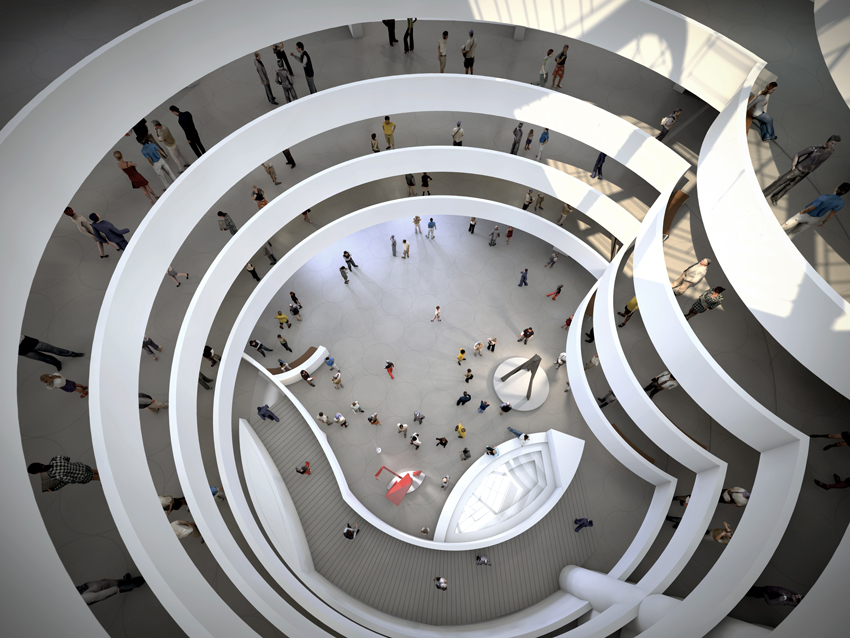
Modeled and Rendered in ARCHICAD
Project: Guggenheim Museum
Location: New York
Architect: Frank Lloyd Wright
This rendering of the Guggenheim, remodeled in BIM, illustrates the beauty of the images that can now be created by this software and the impact of the more realistic lighting capabilities.
Explore the Design in Virtual Reality
Beyond creating beautiful, detailed renderings, the technology now exists to enable designers and clients to walk through these virtual spaces. Some BIM software can export a 3-D file onto an iOS or Android smartphone and allow a designer or client to use a virtual reality platform, such as Google Cardboard, to have an immersive experience of the building design.
Exploring residential and commercial buildings through virtual reality with a smartphone and a viewer offers the design community an avenue for engaging clients and communicating design intent in a high-tech, low-cost way. The BIM files can be exported in under fifteen minutes and will provide images at the resolution level supported by the smartphone technology used.
Some BIM software is capable of providing the files in a number of file formats, enabling designers to save their projects out to third-party applications that may offer higher-resolution images or a more advanced virtual reality experience. While exciting, this third-party compatibility is still cumbersome, requiring intrusive cables that may delay more widespread use.
An interesting use of virtual reality that is emerging as the technology continues to evolve is its use by designers to design. Virtual reality offers designers an unparalleled insight into the scale, layout, flow, proportions, and spatial relationships of the project, providing architects and their team a way for interacting with their design that was previously only possible with the construction of a full-scale mockup. Now a designer may save a basic 3-D model to a smartphone and walk around the space. It provides a powerful perspective during the design process.
In summary, the recent advancements in BIM software have continued to improve every stage of the design and construction process. New tools enable designers to be simultaneously more creative and more productive. The interactive 3-D format allows designers to more quickly visualize new designs and incorporate inspirations onto a project, while these new tools simplify some of the most complex and iterative elements in the building. Stairs, railings, and roofs can be created and modified and moved with clicks of a mouse instead of coordinating pages of disjointed 2-D documents. The use of the 3-D BIM model as the basis for all documentation streamlines workflow and improves collaboration by ensuring that every member of the design team always has access to the most up-to-date version of the building. Improved collaboration and integrated collision detection improves the safety of the overall design by identifying potential weaknesses or issues well before the construction process begins. New BIM software is designed to eliminate much of the busywork and organizational tasks that could best be handled by an interactive repository of all building design and product information. Now designers can focus on their creative process and are empowered to explore new types of space. Ultimately, these are all new benefits of designing with BIM.
Jeanette Fitzgerald Pitts has written dozens of continuing education articles for Architectural Record covering a wide range of building products and practices.
 |
GRAPHISOFT® ignited the BIM revolution in 1984 with ARCHICAD®, the industry's first BIM software for architects. GRAPHISOFT continues to lead the industry with innovative solutions such as its revolutionary BIMcloud®, the world’s first real-time BIM collaboration environment; EcoDesigner™, the world’s first fully BIM-integrated “GREEN” design solution; and BIMx®, the world’s leading mobile app for BIM visualization. GRAPHISOFT is part of the Nemetschek Group. www.graphisoft.com |
Building information modeling (BIM) is an intelligent, digital, model-based process of design, where a building is created using one system of computer models instead of separate sets of drawings. Although BIM is not a new concept or technology, its adoption has skyrocketed over the past decade, and continuous advancements have dramatically improved the productivity, safety, creativity, and collaboration that can be fostered and supported by the BIM-enabled process.
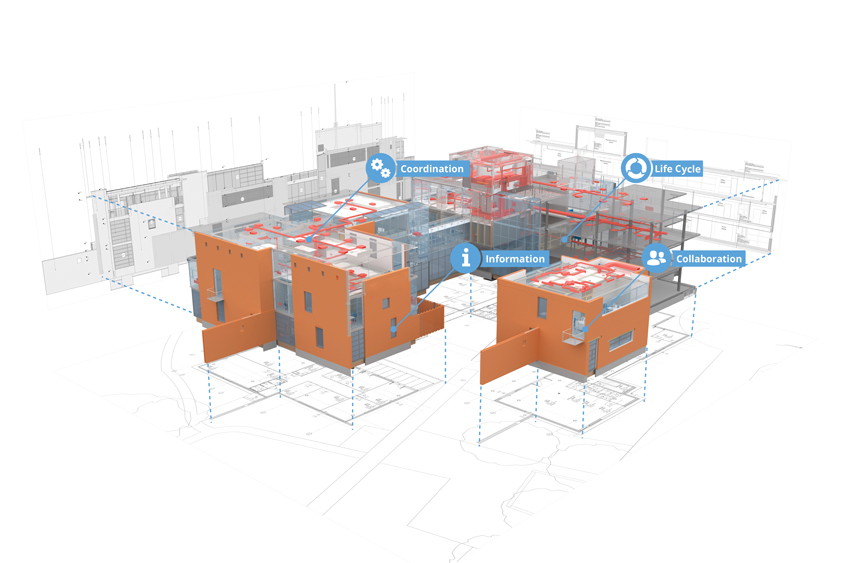
Modeled by GRAPHISOFT
Model: GRAPHISOFT HQ Building
Architect: Építész Stúdió Kft., www.epstudio.hu
BIM organizes the design process so that a building is created using one system of computer models and data instead of a multitude of separate sets of drawings, improving the information available to the team to coordinate and collaborate throughout the design and construction process.
According to the report titled The Business Value of BIM in North America: Multi-Year Trend Analysis and User Ratings (2007–2012) by McGraw-Hill Construction, industry-wide adoption of BIM throughout the architectural, engineering, and construction community in the United States surged from 28 percent in 2007 to 71 percent in 2012. In the past few years, worldwide use of this technology has continued to grow at an impressive rate. The United Kingdom is currently considered the most enthusiastic BIM adopter, with adoption rates estimated at nearly 80 percent. Many countries are requiring the use of BIM for government-funded projects. In South Korea, the Public Procurement Service requires BIM for all public sector projects of a certain size.
One explanation for this incredible increase in BIM adoption points toward the undeniable benefits that BIM now offers. Before BIM, the design process was rigid, sequential, and fragmented, allowing many opportunities for miscommunications, misinformation, and errors to occur. Architects were required to define the project in 2-D and communicate design intent across many separate drawings instead of consolidating the entire project into a single file driven from a 3-D model. Beyond the improved coordination of a project, it is often touted that BIM dramatically streamlines workflow and makes it easier to engage clients in the design process with improved project visualization capabilities, both in 3-D and virtual reality (VR) technologies.
Anthony Laney, Laney LA, describes the moment he knew his firm would make the investment in a BIM solution. “I was sitting at a conference, and a presenter brought out a giant roll of drawings and said, ‘This is option A.’ Then he held up an iPad and said, ‘This is option B,’ and he started spinning the 3-D model and flipping through plans, and I knew right then that this was where we needed to invest.”
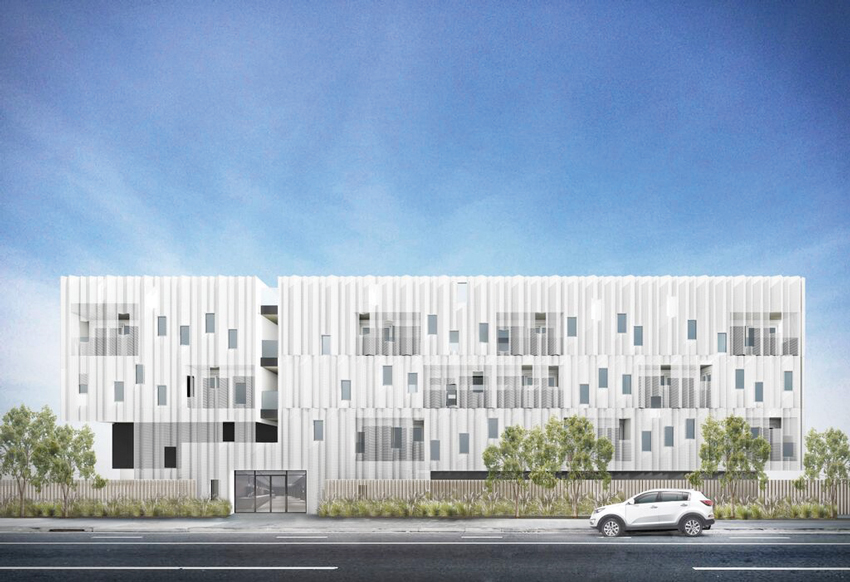
© Laney LA
Project: Carson Residences
Location: Carson, California
“BIM enables the team to engage with the design in a more visually rich way.”
—Anthony Laney, Laney LA, @LaneyLAinc
Using 3-D Architectural BIM Software to Design
The ability to design in 3-D space is one of the most defining features of working in BIM. The software creates a comprehensive 3-D digital model that contains virtual equivalents for the spatial, structural, and mechanical systems included in the project. Designers define the materials, detailing, and spatial characteristics, among other items, in the program, creating layers and layers of metadata that the software uses to generate the 3-D visual representation. As designers interact with the representation, the supporting data is continually updated. This ensures that the incredible amount of information necessary to convey the design intent of a project remains accurate throughout the iterative design process.
Before BIM, architects either drafted buildings manually or with computer-aided design technology, referred to as CAD. Both approaches required architects to design in 2-D, which relied on typing commands into a form to describe the structural and mechanical elements, flesh out the floor plans and elevations, and populate the schedules and sections that comprise the complete drawing set. Once 3-D technology became available, it was only used to create 3-D views and renderings of projects that were designed in 2-D. The 3-D models that could be generated were static, not interactive.
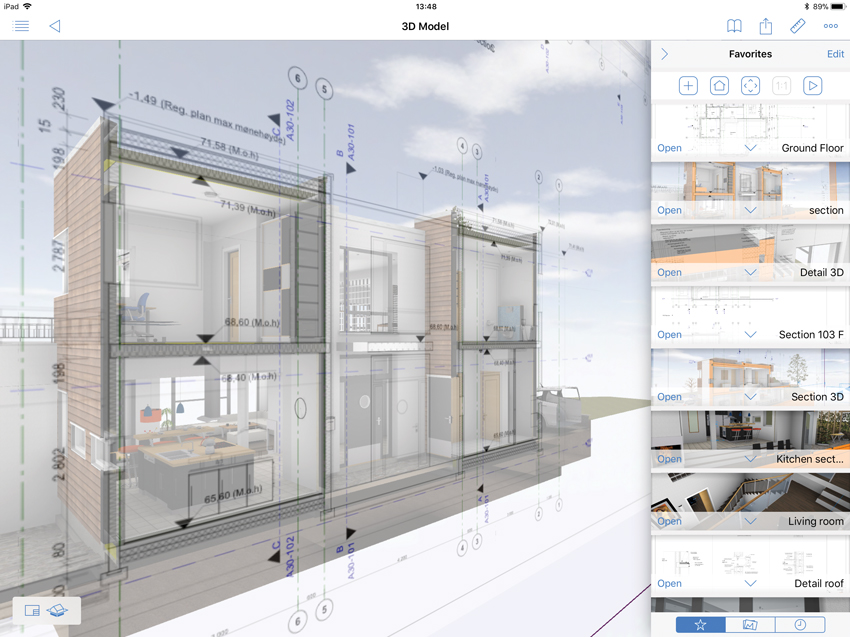
© Villa Funk, Frode Saltkjelvik, GRAPHISOFT Norway
With BIM, architects can design in 2-D or 3-D and modify the design by interacting with the 3-D model of the building.
Now, with BIM, architects can design in 2-D or 3-D and modify the design by interacting with the 3-D model of the building.
This means that designers can still create in the command-driven way they have in the past with a keyboard, or they can use a newer methodology, which essentially allows them to create a building from digital clay, erecting and manipulating the structure more with the mouse than a typed command. For example, instead of pressing Control D to drag an element into a design, the designer can grab it with the mouse and drag it onto the floor plan. Another example of the difference between designing in 2-D and 3-D is that users no longer have to be in a dialogue box to interact with the design—they can do it with a double click.
“I like designing in 3-D a lot more,” explains Allison Cooke, CORE architecture + design, Washington, D.C. “Instead of punching in the characteristics of what you are trying to draw with words and qualifications, this new approach to design helps architects get ideas into a 3-D format more quickly so they can volumetrically study the space.”
Oftentimes, when designing in BIM, architects will work seamlessly between the 2-D and 3-D project views. They will define the dimensional and material qualities of a space in 2-D and see the resulting structure appear in 3-D, getting immediate feedback about how the draft would appear in the real world. Then they can manipulate and interact with the 3-D file.
This flexibility is extremely beneficial throughout the process, especially when designing more complex components, such as the roof. Starting with the edge of the exterior walls or a simple closed polygon outline, multi-plane roofs will model from a conventional roof structure with a few clicks. With BIM, when one plane is modified, the rest of the planes are automatically adjusted to the new geometry. The roof planes can also be edited separately for complex geometries, with the tool calculating new intersections between slopes. The BIM software creates a 3-D model of the roof, enabling an architect to play with the form, change the pitch of the roof by pushing and pulling on the axis, and see the immediate results of the modifications.
New BIM Tools
BIM technology is continuously advancing, adding new capabilities and powerful new tools to the architect’s BIM toolbox. Some of the most impressive new tools now contribute to core architectural design work, helping to create some of the most complex structures and systems in the built environment, including stairs and the railing systems associated with them.
Stair Tool
Designing stairs is one of the most complex tasks in architecture. An acceptable stair design must satisfy special ergonomic considerations, ensuring they are safe and easy to navigate, and meet all applicable national and local codes. Beyond satisfying safety and compliance constraints, another inherent challenge is that the process for creating stairs is especially iterative because the stairs must be reworked whenever changes are made to the greater building structure and consist of multiple subelements, including treads, risers, beams, stringers, and monolithic or cantilevered structures. One exciting new BIM tool employs artificial intelligence to evaluate thousands of design options within the constraints of a specific building and suggest the most optimal stair designs.

Image courtesy of GRAPHISOFT
The new stair tool enables architects to enter a few details about a project and uses artificial intelligence to suggest the most optimal stair designs within the provided constraints.
Using this advanced tool is surprisingly easy. Architects simply enter a few details, such as floor-to-floor height, width of the stairs, rise and run constraints, material composition, the position of the landing, and the specific winder type. Once the pertinent details have been identified, the stair tool is calibrated to review potential stair designs against the defined constraints, ergonomic and safety musts, and applicable code requirements, and then identify the best four stair design solutions. Architects do not need to spend time calculating stair pitch or riser height. They can manipulate the 3-D model with a mouse, reposition the landing, or change the head height, and the tool will reconfigure the stair design automatically in response to the changing parameters. There are also built-in warnings that appear if the design is flawed or impossible as detailed.
Scroll down or click here to see a short video about what the stairs tool can offer.
Railing Tool
Another important new tool creates the complex, associative railings that offer an assist and guidance for people traveling along the stairs created by the stair tool. One of the distinctive features of this tool is that it is not limited to designing railings associated with stairs. The tool views railings as a separate entity and it recognizes that, while a railing can be associative to a flight of stairs, it can also be associative to walls, slabs, roofs, and meshes. Designers can automatically associate railings to several other construction elements, and the geometry of the railing will be automatically updated when the geometry of the host element changes. This tool delivers unique railing patterns specifically designed to fit the needs of a project within the parameters of predefined rules and standards. It is also worth noting that the available associativity options enable the railing tool to develop other building systems as well.
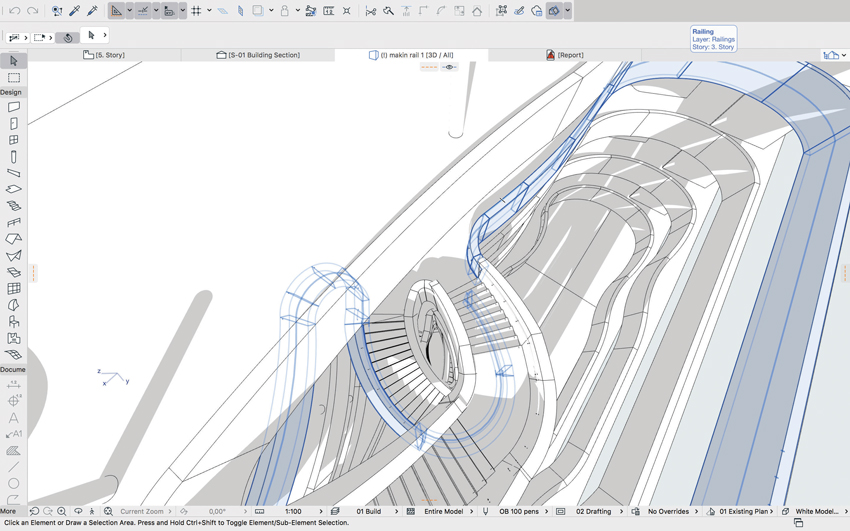
©fjmt
Project: Charles Perkins Centre
Location: Sydney, Australia
Architect: fjmt, fjmtstudio.com
Staircase modeled in BIM
BIM Now Built for Bigger Projects
When BIM was first introduced, computers were equipped with a single core processor. This older technology and limited random access memory (RAM) struggled to churn through the enormous amount of data necessary to build and rebuild the 3-D model. The older technology also had difficulty transitioning between different project views. Back then, architects using BIM spent a lot of time waiting for views to load.
Today, computers feature multi-core processors, fast hard drives, and a lot of RAM. The BIM software has been redesigned to better use the technology now available and apply multithreading techniques and predictive background processing. Those technological improvements coupled with the updates to the BIM software now allow programs to deliver lightning-fast response times and easily handle large, complex models.
These faster BIM solutions effectively harness all available horsepower that a computer has to offer. The program uses all RAM present in a computer, which is one reason it is able to regenerate a 3-D model or project view much more quickly. It also recognizes when current tasks require less than a computer’s full processing power and takes advantage of unused computer capacity to anticipate what a designer may do next and prepare for it in the background.
Making better use of the available processing power allows architects to work in and move through a BIM program much more quickly than they have in the past, but eliminating wait times is not the only way that BIM software improves the efficiency of the design process.
Workflow Improvements
One of the greatest advantages of BIM is that it streamlines the design-to-production workflow for any project. In the past, it was normal for architects to use a lot of different tools throughout the process. There were unique tools for sketching during the conceptual design phase. Then the schematic design phase would begin, and architects would input the 2-D details into a CAD program to create a layout. During design development, architects chose from several tools that create parametric and algorithmic models. There were tools for exploring different materials or systems. There were tools for analyzing the model for compliance with applicable local codes, such as the Americans with Disabilities Act (ADA), and green building rating systems, such as LEED. There were also special tools for rendering 3-D models and completing the necessary project documentation, and the list goes on.
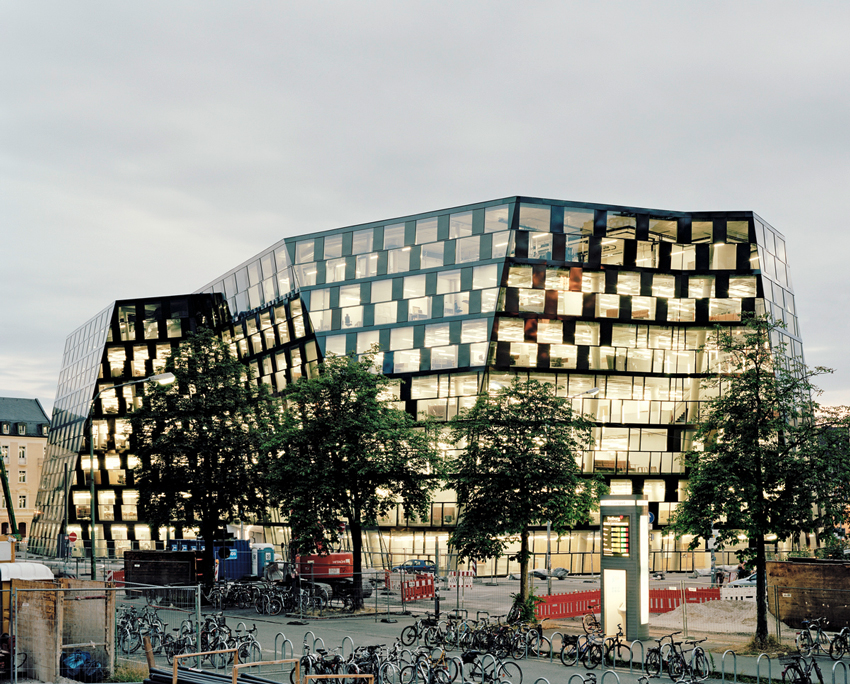
© Barbara Bühler
Project: University Library Freiburg
Location: Germany
Architect: DEGELO ARCHITEKTEN, www.degelo.net
As BIM has evolved, the scope of the BIM software has expanded to include many of the tools and functionalities previously found elsewhere, allowing architects to essentially use one tool as they transition from one design phase to the next. The streamlined process can deliver incredible gains in workflow efficiency for a firm.
“Ninety percent of what we are building now, we are working through within BIM software,” explains Stefan Hampden, principal, CAST Architecture, Seattle. “We used to use a lot of other tools within our process, but now one program is capable of doing those explorations, and we don’t feel like we need to go to another reference and then come back and figure out how to document it.”
Some of the most recent advancements in BIM software allow the BIM process to start even earlier, eliminating the gap that existed between the initial conceptual design phase and when a project could begin in BIM. Now the BIM process can start when a project is initiated because the software includes sketching functionality. Architects can assemble the primitive elements used for massing a project and transform walls, roofs, slabs, doors, windows, beams, columns, curtain walls, stairs, and more. Then they can trace the preliminary design out for a real-world view with the software’s early design modeling capabilities.
Beyond being able to start a project in BIM earlier, there is more flexibility on how that project can be started, allowing architects to continue sketching projects in their preferred formats. Some designers would rather sketch manually or have a favorite sketch program they always use for new projects. Architects who like to begin with manual sketches can take a picture of their drawing with their smartphone and drop it into the software or scan it and use it as the base for the 3-D model. If there is a preferred sketching program, designers can import the drawing file into the BIM software. In short, BIM software now allows architects to begin the BIM process sooner and enables them to continue designing in whichever manner they are the most comfortable.
Integrated Collision Detection
As the design process progresses, more disciplines are added to the team, such as consulting structural and MEP engineers. These team members provide constant, almost daily updates or tweaks to the model that must be reviewed to ensure that no issues between the various elements arise. This responsibility falls to the architect, who is considered the lead coordinator of the model. There are two important features now available in some BIM software that make this multidisciplinary, iterative process easier for an architect to manage. They are the ease with which International Foundation Class (IFC) data files from the consulting engineers can be imported into the BIM software as a reference model and the ability to detect collisions that may exist between the reference models.
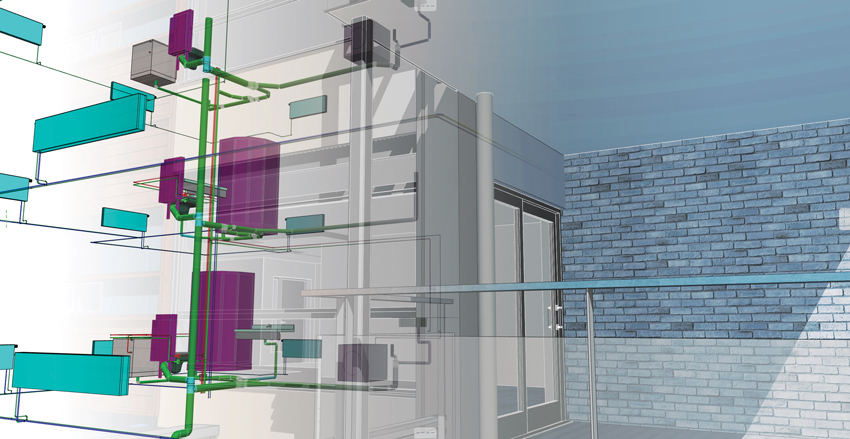
© Rift AS, Oslo, Norway, www.rift.no/
Project: Nordre Jarlsberg Brygge, Norway
In a typical workflow, architects receive a large number of updates to building models. As BIM has become the de facto workflow, architects increasingly receive consultant information in a BIM format referred to as an IFC file. IFC is the global standard for data exchange in the building industry. The ease with which a program can bring these new IFC models into the system is an important feature of project management. One of the most simple and straightforward solutions is to use hotlink modules. Architects can hotlink the external IFC model content created by the engineering consultants to the BIM model. This process enables an architect to work with a structural file, an MEP file, and a site model all from the very same interface.
Once the system updates have been included in the model, the next step is to review the IFC models to look for any issues or conflicts that may exist between the various elements and systems. Referred to as collision detection, this model-based analysis reveals potential flaws and weaknesses in the design, highlights clashing components, and ensures that the design complies with BIM requirements and best practices. In the past, collision detection functionality was not available within the BIM software, requiring architects to use add-on software or external applications to conduct the analysis. Today, BIM software that features integrated collision detection is available, further streamlining the workflow.
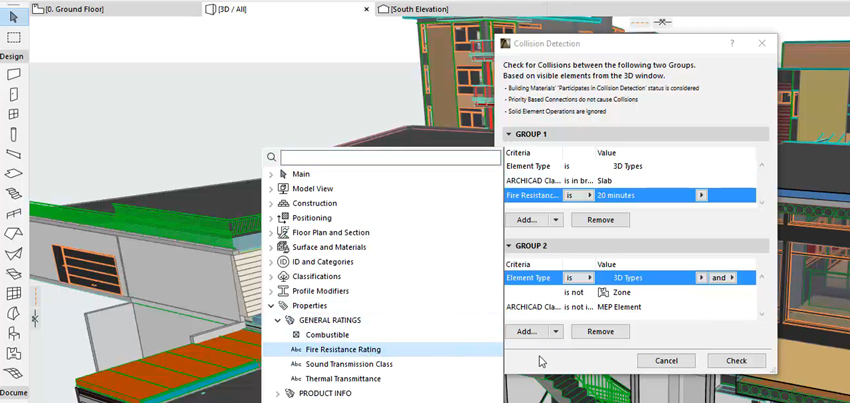
© Rift AS, Oslo, Norway, www.rift.no/
Project: Nordre Jarlsberg Brygge, Norway
Now architects use the collision detection interface within the BIM software to search for issues between different systems. Two systems or components can be compared through user-defined criteria sets, such as element types, classification values, property values, and attributes. This gives architects the ability to filter throughout the extensive model data to compare and contrast the interaction of specific systems in the design. A designer can review the layout of the foundation system in relation to the piping system and look for any instances where the mechanical components have penetrated the conduit, a water pipe collides with a footing, or other types of collisions that may exist between the systems, and then fix them before they cause issues during the construction phase.
Localized Versions Support Local Code Compliance
Some BIM software is available in a localized version that is designed to help architects navigate the way the objects are organized and meet local layout and documentation standards. In some versions of BIM software designed for North America, objects in the library are organized by the CSI standard, which is the method of organization with which architects in this country are most familiar. Measurement units are also provided in what is popular for that area.
In many instances, applicable building and energy codes are defined by the location of the project. These localized BIM versions also contain the local architectural standards and have tools to help architects ensure that their designs are compliant with local codes. For example, designers can use tools within BIM software to ensure that aspects of their layouts meet certain ADA requirements, like providing enough clearance at the pull side of a door or around a toilet.
While the capabilities of the local versions are impressive, there are a number of reasons that architects may want to export an IFC file or other type of design file to use a tool outside of the BIM software. It is increasingly easier for designers to produce the outputs necessary to use add-ons or external applications that will review designs for compliance with certain types of building and energy codes.
Accurate Documentation Made Easy
Historically, the construction documentation phase is where architects spend the majority of their time. Automating the completion and management of the incredible amount of documentation necessary in the building industry is one of the benefits of BIM that is most widely touted. BIM applies a revolutionary approach to documentation in that the model and the documentation are connected to each other. A change to the documentation results in an instant change in the model. A change in the model creates an immediate update to all documentation. Now documentation is a product of the design process and not a separate phase.
As previously described, the BIM process relies upon a single data model that contains layers and layers of metadata that is constantly updated so that all of the details are always current, which is an impressive task considering the iterative nature of the design and construction process. If an architect interacts with the 3-D visualization, pulling or pushing structural elements or redefining materials, the changes ripple down into all of the 2-D documents that pull information from the data model. If an architect makes changes to a 2-D floorplan or detailed section or elevation, the changes are reflected in the 3-D representation and, again, in all documentation.

© Bond Bryan Architects, www.bondbryan.com
Project: Nuclear Advanced Manufacturing Research Centre
Location: Sheffield, United Kingdom
With BIM, any design change is immediately reflected across the complete drawing set. For example, if a designer makes changes to the position or height of a door or window, every elevation and piece of documentation updates with this new information immediately, without requiring the designer to update every associated drawing, schedule, or element description by hand.
This automatic process ensures that architects can clearly and accurately communicate design intent with the model, and it eliminates potential errors that result from project members having the wrong information when iterations or changes are not effectively captured in the documentation. BIM software constantly regenerates the most current version of all documentation so team members are never looking at old or outdated details. This minimizes the opportunities for mistakes to occur from miscommunications that could bust project budgets and timelines.
Improved Collaboration
Before BIM, architects passed base sheets and .dwg files back and forth between the engineers and consultants on their team and had to manually input every iteration. Since then, BIM has revolutionized project collaboration, improving the way that a multidisciplinary team communicates, increasing the level of detail that can be shared visually to improve the clarity of the comments and accommodating the many different ways that team members may prefer to work.
Using BIM, architects can easily exchange IFC files between their consulting engineers and use hotlinking solutions to capture and compare the latest iterations of a system or space quickly and efficiently. Objects that have been changed are color coded depending upon the type of change that occurred. One color represents that an entirely new element has been added. Another color represents that something has been moved or modified. A third highlights items that have been removed.
BIM software also allows designers to customize communications to provide greater levels of detail and clarity to the rest of the team. “With BIM software, I can create a vignette, which allows me to pull a piece of the model out, note it up, and include it alongside the orthographic representations of the drawing. It’s a clearer way for me to communicate design intent to the engineer. I can say ‘I want to bury this beam, and I want that to pull out,’ but being able to show them a shot of the model and provide a couple of notes and put that in next to the more traditional drawing is huge,” Hampden explains.
Beyond offering tools to help architects communicate more clearly with the team at large, BIM software offers greater flexibility to support the ways in which consulting engineers prefer to work with the architect. The system can still accommodate .dwg files for design consultants who prefer to complete documentation in 2-D.
The system also enables the team to collaborate in real time on the building models. Architects and structural engineers can work in the same drawing at the same time, see each other’s work, and join the real-time work session from inside the office or a remote location. This gives the design team the ability to be more flexible with each other.
Another BIM feature that makes collaboration easier today is platform neutrality. In the past, platform mattered because it was a challenge to work on projects across iOS and Android devices. The programs were not capable of jumping across platforms in a way that protected the integrity of the original files and was easy to use. Now programs offer seamless design and review capabilities across iOS and Android platforms, making it much easier to collaborate among all project stakeholders regardless of their device preferences.
The Mobile BIM Model
BIM is built upon a database that contains an enormous amount of information about a project. The value of BIM, however, is not that the database exists but that the data can be easily and readily accessed by all of the members of the AEC team. Ensuring the members of the multidisciplinary AEC team, which is often comprised of an MEP engineer, environmental engineer, civil engineer, architect, structural engineer, interior architect, landscape architect, surveyor, general contractor, and subcontractors, is especially challenging because many of the stakeholders are not proficient in BIM or do not have a computer, relying instead upon a mobile device.

Photo courtesy of GRAPHISOFT
With BIM, accurate project data can be easily and readily accessed by all members of the AEC team from a preferred mobile device.
It is now possible to load the hyper-model of a BIM project and the associated documentation onto a mobile device and take it to the job site, to the client meeting, or anywhere. Now, if an architect is at a construction site discussing an issue with the construction manager, the architect can access the model on his or her mobile phone and even send it directly to the construction manager’s tablet. With BIM being mobile, architects and the rest of the team can share and collaborate on projects using the full range of hardware, tablets, and smartphones they possess.
“The mobile BIM solution has enabled our designs to break free of the confines of the desktop and the studio itself. Now we are able to have the entire rich 3-D model in our pockets. We can put it on the iPad Pro and take it to a construction site. We can upload it to the cloud. With this level of access, structural engineers, general contractors, and real-estate sales people can engage with the design in a much more visually rich way,” says Anthony Laney, Laney LA.
More Beautiful Renderings
BIM can also produce strikingly beautiful images in a still format, animation, or interactive hyper-model, offering the photo-realistic solution for any type of presentation need.
“I was resistant to change everything I do [and make the switch to BIM], but I did see the beauty of what it offered. My first great experience with the BIM software, where the product really upped my game, was the time I presented renderings to the developer of a huge apartment complex. There is nothing I could have drawn that would have elicited that response. They were gorgeous renderings, and the client said, ‘We want to live in that rendering,’” shares Olvia Demetriou, HapstakDemetriou.
Some BIM software now features an integrated rendering engine that offers designers an everyday 3-D window that quickly generates high-quality renderings and project images. This built-in sketch rendering capability makes good presentations filled with project renderings possible on the fly. This is a dramatic departure from past technologies that required architects to dedicate significant time just to developing the images that would be used during a presentation. The software can also produce marquees that carve up the model and provide unique views for clients or members of the consulting engineer or construction team. Animations can also be created by connecting the rendered images with a camera path.
Nudging the quality higher, the sophisticated rendering engine is equipped with light mapping and global illumination (GI) capabilities that adds more realistic lighting to 3-D images. The images now consider light produced by a light source as well as the reflections, refractions, and shadows that occur as a result of the light’s path through a space. These improved renderings create brighter interiors and a better representation of the depth of a room.

Modeled and Rendered in ARCHICAD
Project: Guggenheim Museum
Location: New York
Architect: Frank Lloyd Wright
This rendering of the Guggenheim, remodeled in BIM, illustrates the beauty of the images that can now be created by this software and the impact of the more realistic lighting capabilities.
Explore the Design in Virtual Reality
Beyond creating beautiful, detailed renderings, the technology now exists to enable designers and clients to walk through these virtual spaces. Some BIM software can export a 3-D file onto an iOS or Android smartphone and allow a designer or client to use a virtual reality platform, such as Google Cardboard, to have an immersive experience of the building design.
Exploring residential and commercial buildings through virtual reality with a smartphone and a viewer offers the design community an avenue for engaging clients and communicating design intent in a high-tech, low-cost way. The BIM files can be exported in under fifteen minutes and will provide images at the resolution level supported by the smartphone technology used.
Some BIM software is capable of providing the files in a number of file formats, enabling designers to save their projects out to third-party applications that may offer higher-resolution images or a more advanced virtual reality experience. While exciting, this third-party compatibility is still cumbersome, requiring intrusive cables that may delay more widespread use.
An interesting use of virtual reality that is emerging as the technology continues to evolve is its use by designers to design. Virtual reality offers designers an unparalleled insight into the scale, layout, flow, proportions, and spatial relationships of the project, providing architects and their team a way for interacting with their design that was previously only possible with the construction of a full-scale mockup. Now a designer may save a basic 3-D model to a smartphone and walk around the space. It provides a powerful perspective during the design process.
In summary, the recent advancements in BIM software have continued to improve every stage of the design and construction process. New tools enable designers to be simultaneously more creative and more productive. The interactive 3-D format allows designers to more quickly visualize new designs and incorporate inspirations onto a project, while these new tools simplify some of the most complex and iterative elements in the building. Stairs, railings, and roofs can be created and modified and moved with clicks of a mouse instead of coordinating pages of disjointed 2-D documents. The use of the 3-D BIM model as the basis for all documentation streamlines workflow and improves collaboration by ensuring that every member of the design team always has access to the most up-to-date version of the building. Improved collaboration and integrated collision detection improves the safety of the overall design by identifying potential weaknesses or issues well before the construction process begins. New BIM software is designed to eliminate much of the busywork and organizational tasks that could best be handled by an interactive repository of all building design and product information. Now designers can focus on their creative process and are empowered to explore new types of space. Ultimately, these are all new benefits of designing with BIM.
Jeanette Fitzgerald Pitts has written dozens of continuing education articles for Architectural Record covering a wide range of building products and practices.
 |
GRAPHISOFT® ignited the BIM revolution in 1984 with ARCHICAD®, the industry's first BIM software for architects. GRAPHISOFT continues to lead the industry with innovative solutions such as its revolutionary BIMcloud®, the world’s first real-time BIM collaboration environment; EcoDesigner™, the world’s first fully BIM-integrated “GREEN” design solution; and BIMx®, the world’s leading mobile app for BIM visualization. GRAPHISOFT is part of the Nemetschek Group. www.graphisoft.com |























